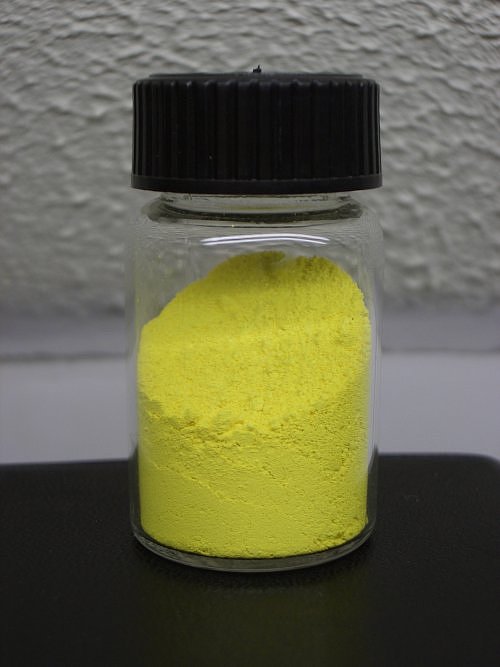Cadmium powder 99,99%
Cadmium / cadmium powder

Cadmium Metal
cadmium
Cadmium is most commonly found in nature as a minor component of zinc ores. This fact led 1817 to its discovery by Samuel Leberecht Hermann and Friedrich Stromeyer, who studied impurities in a sample of the zinc carbonate mineral Calamin (or Cadmia in Latin), from which the name of the element was later derived.
Cadmium found a variety of applications soon after its discovery. The first noteworthy uses of cadmium were red, orange, and yellow cadmium sulfide -selenated pigments, already in the forties of the 19. Century were used on a small scale. Cadmium pigments are valued for their liveliness and durability, and at the time of their introduction, there were few options for stable pigments in this color range. As the production of cadmium metal on an industrial scale in the early 20. Century began, cadmium pigments became more popular and other applications followed. Because cadmium is resistant to corrosion, it can be electrodeposited to serve as a protective coating for lightly corrosive metals such as steel. Nickel-cadmium (NiCd) batteries were first invented by 1899, but were generally manufactured in the middle of the 40 years. For the next fifty years, they were the primary rechargeable batteries for consumer electronics. Cadmium may also be a component of silver-based solder alloys which are versatile, have high strength and uniquely low melting point. Cadmium compounds can be used to stabilize PVC plastics, significantly increasing their resistance to heat and general wear.
Unfortunately, the use of cadmium has had a major disadvantage for all of these applications: cadmium and many of its compounds are extremely toxic. The poisoning by metal fumes or cadmium dust is often acute and causes severe flu-like symptoms, respiratory problems and damage to the liver and kidneys within hours of exposure. Acute organ damage can also be caused by ingesting large amounts of cadmium compounds. Long-term low-level exposure, however, can also lead to insidious damage, leading to progressive kidney disease, gout and dangerously weak bones, leading to severe pain and fractures. Cadmium in industrial waste, landfills and mines easily enter the groundwater and can be used in drinking water or collected in crops. All plants can pick up some cadmium from the soil, but some tend to concentrate the metal, which sometimes leads to tragic mass poisoning.
Concerns over the toxicity of cadmium have led to workplace safety regulations, battery recycling programs and a significant decline in traditional uses of the metal. Alternative pigments such as cerium sulphide and azo pigments are now available for many applications, although some paints still contain cadmium. For most applications of corrosion resistant thin films, a zinc or aluminum coating can serve the same purpose as a cadmium coating. Few soldering formulas still contain cadmium, and alternative stabilizers have been developed for the manufacture of PVC products. Finally, nickel-metal hydride (NiMH) and lithium-ion batteries for rechargeable batteries in consumer electronics are becoming economically and functionally comparable alternatives to Ni-Cd, although Ni-Cd batteries still have the benefits they provide for some specialty applications recommend.
A relatively new application of cadmium in compound semiconductors is becoming increasingly important. Cadmium can form II-VI class semiconductor compounds with selenium, tellurium and sulfur, as well as being part of several ternary semiconductors. Currently, the largest use of cadmium semiconductors is in cadmium telluride thin-film photovoltaics, but also in radiation detectors, electro-optic modulators, optical windows and lenses, photoresistors, and lasers. In addition, ongoing research on nanoscale cadmium semiconductor crystals such as cadmium selenide quantum dots has yielded promising results for a variety of applications, including more efficient LED illumination.
Cadmium is relatively rare and there are no common cadmium ores. Therefore, the element is still commercially obtained today as a by-product of zinc mining. Cadmium sulfide is the most abundant compound in zinc ores. Because it is easy to insulate and clean, it is the main source of cadmium for industrial applications.

Cadmium Powder
Cadmium Powder 99,99%
Highly pure cadmium powder with the smallest possible average grain sizes is used for the production of pressed and bonded sputtering targets as well as for chemical vapor deposition (CVD) and physical vapor deposition (PVD) processes, including thermal and electron beam processes (e-beam) evaporation, organic evaporation at low temperature, atomic Layer Deposition (ALD), organometallic and chemical vapor deposition (MOCVD). Powders are also suitable for all applications where large surface areas are desired, e.g. B. for water treatment as well as for fuel cell and solar applications. Nanoparticles also produce very high surfaces. Standard powder particle sizes averages in the range of -325 mesh, -100 mesh, 10-50 microns, and submicron (<1 micron). Materials in the nano range can also be created. There are standard grades including Mil Spec (military grade); ACS, reagent and technical grade; Food, agricultural and pharmaceutical quality; Optical quality, USP and EP / BP (European Pharmacopoeia / British Pharmacopoeia) and follows the applicable ASTM test standards. Cadmium is also manufactured in rods, ingots, pieces, pellets, discs, granules, wire and in composite forms such as oxide.
Cadmium Powder 99,99% price
Prices for cadmium powder 99,99% -> prices for high-purity metals
